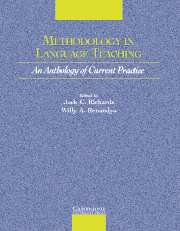Book contents
- Frontmatter
- Contents
- Acknowledgments
- Introduction
- Section I Approaches to Teaching
- Section 2 Lesson Planning and Classroom Management
- Section 3 Classroom Dynamics
- Section 4 Syllabus Design and Instructional Materials
- Section 5 Task and Project Work
- Section 6 Learning Strategies
- Section 7 Teaching Grammar
- Section 8 Teaching Pronunciation
- Section 9 Teaching Speaking
- Section 10 Teaching Listening
- Section 11 Teaching Vocabulary
- Chapter 24 Current Research and Practice in Teaching Vocabulary
- Chapter 25 Best Practice in Vocabulary Teaching and Learning
- Section 12 Teaching Reading
- Section 13 Teaching Writing
- Section 14 Assessment
- Section 15 Technologies in the Classroom
- Section 16 Professional Development
- Credits
- Author Index
- Subject Index
- References
Chapter 25 - Best Practice in Vocabulary Teaching and Learning
Published online by Cambridge University Press: 10 November 2010
- Frontmatter
- Contents
- Acknowledgments
- Introduction
- Section I Approaches to Teaching
- Section 2 Lesson Planning and Classroom Management
- Section 3 Classroom Dynamics
- Section 4 Syllabus Design and Instructional Materials
- Section 5 Task and Project Work
- Section 6 Learning Strategies
- Section 7 Teaching Grammar
- Section 8 Teaching Pronunciation
- Section 9 Teaching Speaking
- Section 10 Teaching Listening
- Section 11 Teaching Vocabulary
- Chapter 24 Current Research and Practice in Teaching Vocabulary
- Chapter 25 Best Practice in Vocabulary Teaching and Learning
- Section 12 Teaching Reading
- Section 13 Teaching Writing
- Section 14 Assessment
- Section 15 Technologies in the Classroom
- Section 16 Professional Development
- Credits
- Author Index
- Subject Index
- References
Summary
INTRODUCTION
Research on second language acquisition can be interpreted to show that a well-balanced language course should contain four major strands: meaning-focused input, meaning-focused output, fluency development and language-focused instruction. The inclusion of a language-focused instruction strand is not a reaction to communicative approaches but is the result of research findings that courses that contain such a strand are likely to achieve better results than courses that do not contain such a strand (Long, 1988; Ellis, 1990). For most second language learners, language-focused vocabulary instruction is an essential part of a language course.
The aim of this article is to show how the vocabulary component of a language course fits into these four strands. The assumption is that vocabulary growth is such an important part of language acquisition that it deserves to be planned for, deliberately controlled and monitored. There is a growing body of theory and research findings that can guide us in doing this.
VOCABULARY AND MEANING-FOCUSED INPUT
Reading has long been seen as a major source of vocabulary growth. Research indicates that, for several reasons, there is a fragility to this kind of learning. First, research with native speakers of English shows that the amount of vocabulary learning that occurs during the reading of a text is rather small (Nagy, Herman, & Anderson, 1985). It is necessary to use sensitive tests of vocabulary knowledge to show any learning at all.
Information
- Type
- Chapter
- Information
- Methodology in Language TeachingAn Anthology of Current Practice, pp. 267 - 272Publisher: Cambridge University PressPrint publication year: 2002
References
Accessibility standard: Unknown
Why this information is here
This section outlines the accessibility features of this content - including support for screen readers, full keyboard navigation and high-contrast display options. This may not be relevant for you.Accessibility Information
- 9
- Cited by
